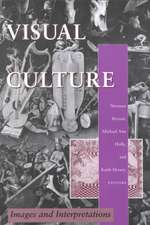Word and Image: French Painting of the Ancien Régime
Autor Norman Brysonen Limba Engleză Paperback – 27 ian 1983
Preț: 338.57 lei
Nou
Puncte Express: 508
Preț estimativ în valută:
64.78€ • 67.64$ • 53.62£
64.78€ • 67.64$ • 53.62£
Carte tipărită la comandă
Livrare economică 05-19 aprilie
Preluare comenzi: 021 569.72.76
Specificații
ISBN-13: 9780521276542
ISBN-10: 0521276543
Pagini: 300
Dimensiuni: 175 x 247 x 19 mm
Greutate: 0.76 kg
Ediția:Revised
Editura: Cambridge University Press
Colecția Cambridge University Press
Locul publicării:Cambridge, United Kingdom
ISBN-10: 0521276543
Pagini: 300
Dimensiuni: 175 x 247 x 19 mm
Greutate: 0.76 kg
Ediția:Revised
Editura: Cambridge University Press
Colecția Cambridge University Press
Locul publicării:Cambridge, United Kingdom
Cuprins
List of illustrations; Preface; Acknowledgements; 1. Discourse, figure; 2. The legible body: LeBrun; 3. Watteau and reverie; 4. Transformations in rococo space; 5. Greuze and the pursuit of happiness; 6. Diderot and the word; 7. Diderot and the image; 8. 1785; Conclusion: style or sign?; Notes; List of societies affiliated to CINOA; Select bibliography; Index.
Recenzii
'Word and Image repays the effort it demands in heaped measure, because Norman Bryson writes with rare intellectual exhilaration. On page after page, he detonates fresh ideas carrying far wider repercussions than his immediate subject matter. He himself has a way of turning pedagogy into pyrotechnics, just as the painters whom he discusses here with such commitment - LeBrun, Watteau, Greuze, Chardin, David - transform moral enigmas into paint.' Marina Warner, The Sunday Times
Descriere
A classic work from 1982 which changed the face of art criticism in the twentieth century.

















